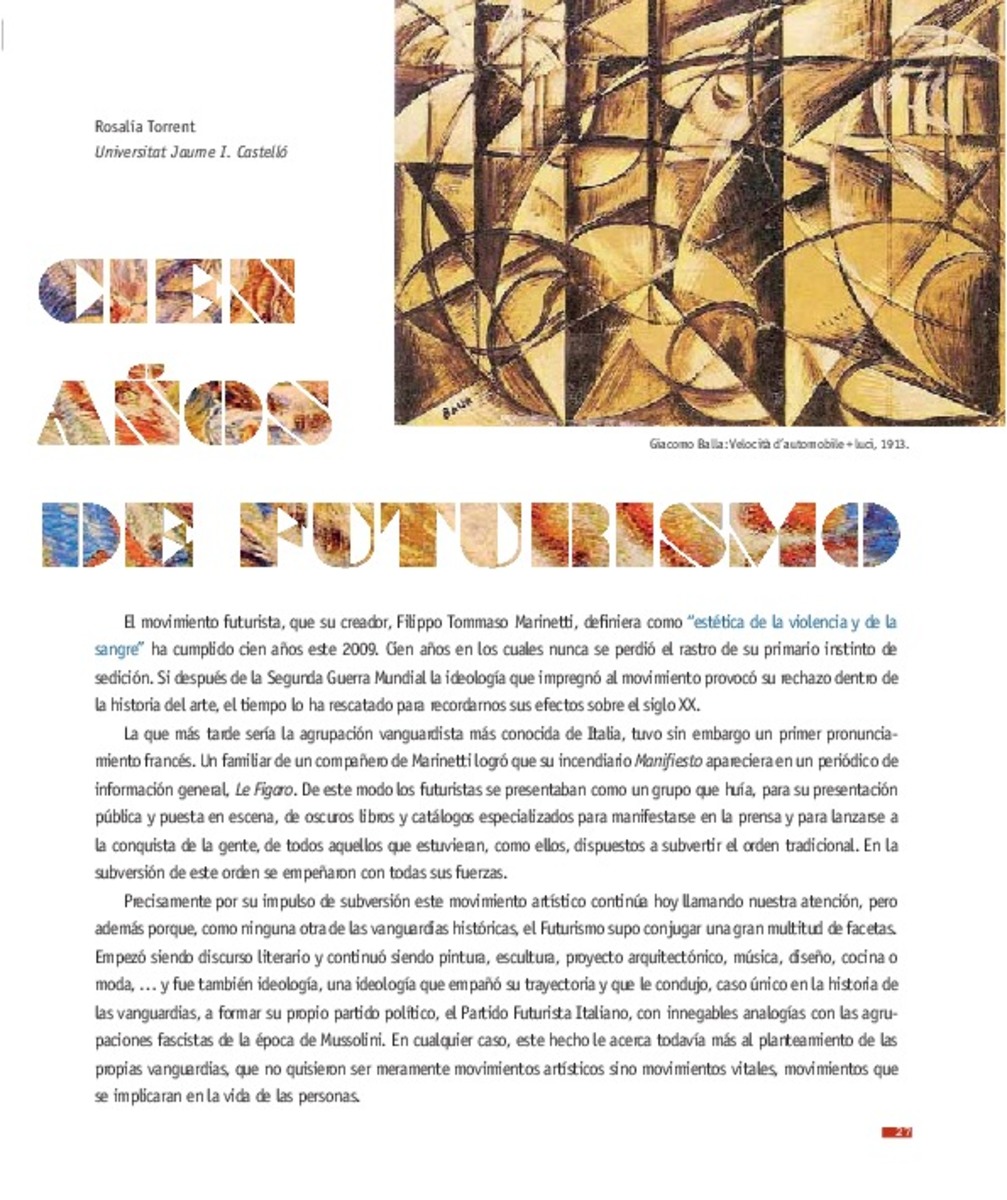Mostrar el registro sencillo del ítem
Cien años de futurismo
| dc.contributor.author | Torrent, Rosalía | |
| dc.date.accessioned | 2012-04-28T07:10:30Z | |
| dc.date.available | 2012-04-28T07:10:30Z | |
| dc.date.issued | 2009 | |
| dc.identifier.citation | CBN: revista de estética y arte contemporáneo (2009), año 1, no. 1, 27-35 | |
| dc.identifier.issn | 1888-9719 | |
| dc.identifier.uri | http://hdl.handle.net/10234/35760 | |
| dc.description.abstract | El movimiento futurista, que su creador, Filippo Tommaso Marinetti, definiera como “estética de la violencia y de la sangre” ha cumplido cien años este 2009. Cien años en los cuales nunca se perdió el rastro de su primario instinto de sedición. Si después de la Segunda Guerra Mundial la ideología que impregnó al movimiento provocó su rechazo dentro de la historia del arte, el tiempo lo ha rescatado para recordarnos sus efectos sobre el siglo XX. Por su impulso de subversión este movimiento artístico continúa hoy llamando nuestra atención, pero además porque, como ninguna otra de las vanguardias históricas, el Futurismo supo conjugar una gran multitud de facetas. Empezó siendo discurso literario y continuó siendo pintura, escultura, proyecto arquitectónico, música, diseño, cocina o moda, … y fue también ideología, una ideología que empañó su trayectoria y que le condujo, caso único en la historia de las vanguardias, a formar su propio partido político, el Partido Futurista Italiano, con innegables analogías con las agrupaciones fascistas de la época de Mussolini. En cualquier caso, este hecho le acerca todavía más al planteamiento de las propias vanguardias, que no quisieron ser meramente movimientos artísticos sino movimientos vitales, movimientos que se implicaran en la vida de las personas | |
| dc.description.abstract | In 2009 the Futurist movement, which was defined by its creator, Filippo Tommaso Marinetti, as “an aesthetic of violence and blood”, celebrated its first centenary. Over those hundred years the track of its primary instinct for sedition has never been lost. Although in the period following the Second World War the ideology that impregnated the movement led it to be rejected within the history of art, time has salvaged it so as to remind us of its effects on the 20th century. This artistic movement still draws our attention today, not only because of its subversive impulse, but also because, like no other historic avant-garde movement, Futurism succeeded in fitting together a wide range of different aspects. It started out as literary discourse and went on to become painting, sculpture, architectural projects, music, design, cuisine or fashion… yet it was also an ideology – indeed an ideology that tarnished its course and led it to become the first and only case of an avant-garde movement to form its own political party, the Italian Futurist Party, with undeniable analogies with the fascist groups from the times of Mussolini. In any case, this fact draws it even closer to the viewpoint of the avant-garde movements, which sought to go beyond the status of merely artistic movements and develop instead into vital movements, movements that became involved in people’s lives | |
| dc.format.extent | 9 p. | |
| dc.format.mimetype | application/pdf | |
| dc.language.iso | spa | |
| dc.publisher | Collblanc | |
| dc.rights | © Collblanc | |
| dc.rights.uri | http://rightsstatements.org/vocab/InC/1.0/ | * |
| dc.subject | Futurismo | |
| dc.subject | Vanguardias artísticas | |
| dc.subject | Arte moderno | |
| dc.subject | S. XX | |
| dc.subject | Subversión | |
| dc.subject | Futurism | |
| dc.subject | Avant-garde artistic movements | |
| dc.subject | Modern art | |
| dc.subject | 20th century | |
| dc.subject | Subversion | |
| dc.subject.lcsh | Futurism (Art) | |
| dc.subject.other | Futurisme (Art) | |
| dc.title | Cien años de futurismo | |
| dc.type | info:eu-repo/semantics/article | |
| dc.rights.accessRights | info:eu-repo/semantics/openAccess | |
| dc.relation.publisherVersion | http://collblanc.es/Collblanc/Revista_files/CBN_01.pdf | |
| dc.type.version | info:eu-repo/semantics/publishedVersion |
Ficheros en el ítem
Este ítem aparece en la(s) siguiente(s) colección(ones)
-
HIS_Articles [428]
Articles de publicacions periòdiques







